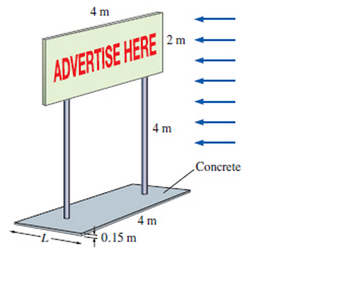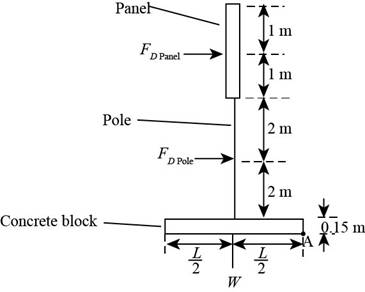
A 2-zn-high, 4-zn-wide rectangular advertisement panel is attached to a 4-rn-wide. 0.15-rn-high rectangular concrete block (density = 2300 kg/m3) by two 5-cm-diameter. 4-m-high (exposed part) poles, as shown in Fig. 11-96. If the sign is to withstand 150 kin/h winds from any direction, determine (a) the maximum drag force on the panel. (b) the drag force acting on the poles, and (c) the minimum length L of the concrete block for the panel to resist the winds. Take the density of air to be 1.30 kg/m3.

(a)
The maximum drag force on the panel.
Answer to Problem 96P
The maximum drag force on the panel is
Explanation of Solution
Given information:
The height of the rectangular advertisement panel is
Write the expression for the drag force for the panel.
Here, the drag force coefficient is
Write the expression for the frontal area of the panel.
Here, the height of the rectangular advertisement panel is
Calculation:
The drag coefficient for the turbulent flow for the thin rectangular plate is
Substitute
Substitute
Conclusion:
The maximum drag force on the panel is
(b)
The drag force acting on the pole.
Answer to Problem 96P
The drag force acting on the pole is
Explanation of Solution
Write the expression for the frontal area of the pole.
Here, the diameter of the pole is
Write the expression for the drag force for the pole.
Calculation:
The drag coefficient for the turbulent flow for circular rod is
Substitute
Substitute
Conclusion:
The drag force acting on the pole is
(c)
The minimum length
Answer to Problem 96P
The minimum length
Explanation of Solution
Draw the diagram for the side view of the advertisement panel.

Figure-(1)
Write the expression for the moment about point A.
Here, the minimum length of the concrete block for the panel to resist the winds is
Write the expression for the weight of the concrete block.
Here, the mass of the block is
Write the expression for the volume of the block.
Here, the height of the rectangular concrete block is
Write the expression for the mass of the block.
Here, the density of the concrete block is
Substitute
Substitute
Calculation:
Substitute
Substitute
Conclusion:
The minimum length
Want to see more full solutions like this?
Chapter 11 Solutions
Fluid Mechanics: Fundamentals and Applications
- A cloud of coal particles is traveling through a system. The cloud diameter estimated to be 0.027 m and the individual particles are 50 um in diameter with the density of 1300 kg/m'. The total cloud is moving such that its drag coefficient is constant at 0.44. The individual particles in the cloud move much slower, such that the drag coefficient given by stock's law. The system has atmospheric air transporting and the cloud density is 190 kg/m3. Determine the ratio of internal velocity to cloud velocity. Atmospheric air density 1.2 kg/m'.arrow_forwardThe drag coefficient for a car with a frontal area of 26 ft? is being measured in an 8 ft x 8 ft wind tunnel. The density of air under the test conditions is 2.4 x 10 3 slugs/ft, When the air flow rate is, 500,000 ft/min, the drag force on the car was measured to be 170 lb. The drag coefficient under the test conditions is most nearly O 0.30 O 0.32 O 0.28 O 0.34arrow_forwardA rotary mixer is constructed from two circular disks as shown. The mixer is rotated at 60 rpm in a large vessel containing a brine solution (SG = 1.1, μbrine=1.07×10-3 Pa-s). Determine the appropriate coefficient of drag using Low Reynolds Drag Coefficient. Neglect the drag on the rods and the motion induced in the liquid. Estimate the minimum torque and power required to drive the mixer. only HANDWRITTEN answer needed ( NOT TYPED)arrow_forward
- A 1.5-m-long and 0.5 m wide flat plate is immersed in water flow with velocity of kg 5 m/s. (F = 1000 =1.02 x10- m Determine; (a) The boundary layer thickness at leading edge of the plate, (b) The drag coefficient and the drag force, (c) the drag coefficient and force, if the flow is laminar at the entrance (Rex, ait= 106), (d) the drag force, if the roughness height & is 0.2 mm on the plate.arrow_forwardAnswer correctly. Here is the Translation. "A luxury sports car has an area of 2 m² and there is a drag coefficient of 0.29 at a speed of 90 km/h. Calculate the drag force exerted on the car at this speed"arrow_forwardA 0.80-m-diameter, 1.2-m-high garbage can is found in the morning tipped over due to high winds during the night. Assuming the average density of the garbage inside to be 150 kg/m3 and taking the air density to be 1.25 kg/m3, estimate the wind velocity during the night when the can was tipped over. Take the drag coefficient of the can to be 0.7.arrow_forward
- 1. Zero Lift Drag Coefficient" is a sum of: \C poum |Cp CDOF DoL 1 Marrow_forwardThe form drag coefficient of a certain light aircraft is equal to 0.02. Its skin friction drag coefficient is 0.009. Determine its maximum lift-to-drag ratio (nearest hundredths) if its interference drag is 8 percent of its profile drag. The aircraft has an elliptical wing with an aspect ratio of 6.9.arrow_forwardis the drag coefficient 2 or 0.2?arrow_forward
- 8. A flat plate ( 1.5 m ) long and ( 1.5 m ) wide is towed in water ( p = 1000 kg/m and v=1.31 * 10 “ m² / s ) in the direction of its length at a speed of ( 20 cm / s ). %3D Determine; a) The skin frictional drag force on both sides of the plate. b) The boundary layer thickness at the end of the plate.arrow_forwardQ2.Aarrow_forwardIn your own words, list at least three “red flags” to look out for when performing laminar boundary layer calculations.arrow_forward
 Elements Of ElectromagneticsMechanical EngineeringISBN:9780190698614Author:Sadiku, Matthew N. O.Publisher:Oxford University Press
Elements Of ElectromagneticsMechanical EngineeringISBN:9780190698614Author:Sadiku, Matthew N. O.Publisher:Oxford University Press Mechanics of Materials (10th Edition)Mechanical EngineeringISBN:9780134319650Author:Russell C. HibbelerPublisher:PEARSON
Mechanics of Materials (10th Edition)Mechanical EngineeringISBN:9780134319650Author:Russell C. HibbelerPublisher:PEARSON Thermodynamics: An Engineering ApproachMechanical EngineeringISBN:9781259822674Author:Yunus A. Cengel Dr., Michael A. BolesPublisher:McGraw-Hill Education
Thermodynamics: An Engineering ApproachMechanical EngineeringISBN:9781259822674Author:Yunus A. Cengel Dr., Michael A. BolesPublisher:McGraw-Hill Education Control Systems EngineeringMechanical EngineeringISBN:9781118170519Author:Norman S. NisePublisher:WILEY
Control Systems EngineeringMechanical EngineeringISBN:9781118170519Author:Norman S. NisePublisher:WILEY Mechanics of Materials (MindTap Course List)Mechanical EngineeringISBN:9781337093347Author:Barry J. Goodno, James M. GerePublisher:Cengage Learning
Mechanics of Materials (MindTap Course List)Mechanical EngineeringISBN:9781337093347Author:Barry J. Goodno, James M. GerePublisher:Cengage Learning Engineering Mechanics: StaticsMechanical EngineeringISBN:9781118807330Author:James L. Meriam, L. G. Kraige, J. N. BoltonPublisher:WILEY
Engineering Mechanics: StaticsMechanical EngineeringISBN:9781118807330Author:James L. Meriam, L. G. Kraige, J. N. BoltonPublisher:WILEY





